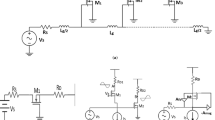Abstract
The Low Noise Amplifier (LNA) is the first stage in RF CMOS receivers. The Common Gate (CG) LNA and Inductively Degenerated Common Source (CS) LNA are one of the widely used topologies for realizing RF CMOS receivers. The present work emphasizes a simple and exhaustive search procedure for the synthesis and analysis of CMOS CG and Inductively Degenerated CS LNA circuits. The width (W), gate source voltage (\( V_{gs} \)) and drain source voltage (\( V_{ds} \)) of the transistors constitute the design space in the circuit design. The design first involves the use of a circuit simulator (HSPICE) to obtain the small signal parameters of the circuit for various W, \( V_{gs}\), and \( V_{ds} \)of the transistors and then to generate a Look-Up Table (LUT) for all design points using the obtained values. This LUT is used to meet the target performance specifications along with appropriate analytical expressions derived from the circuit in a numerical simulator (MATLAB). This will enable one to explore the whole design space quickly and fastly for arriving at the optimal values for the device dimensions, bias voltages and bias currents of the two LNA circuits. The design methodology is demonstrated by designing CG and Inductively Degenerated CS LNA circuits using 90 nm CMOS technology library in which Inductively Degenerated CS LNA gets high gain and low noise figure than CG LNA.









Similar content being viewed by others
References
Baroncini, Virgínia Helena Varotto and Oscar da Costa Gouveia-Filho 2004 Design of RF CMOS low noise amplifiers using a current based MOSFET model. In: Proceedings of International Symposium on Integrated circuits and system design 82–87
Blaakmeer, Stephan C, Eric A M Klumperink, Domine M W Leenaerts and Bram Nauta 2008 Wideband Balun-LNA with simultaneous output balancing, noise-canceling and distortion-canceling. IEEE Journal of Solid-State Circuits 43: 1341–1350
Chen, Wei-Hung, Gang Liu, Boos Zdravko and Ali M Niknejad 2008 A highly linear broadband CMOS LNA employing noise and distortion cancellation. IEEE Journal of Solid-State Circuits 43(5): 1164–1176
Manstretta and Danilo 2012 A broadband low-power low-noise active balun with second-order distortion cancellation. IEEE Journal of Solid-State Circuits 47: 407–420
Ansari, Amirhossein and Mohammad Yavari 2011 A very wideband low noise amplifier for cognitive radios. In: Proceedings of 18th IEEE Int Conf. On Electronics, Circuits and System: 623–626
Feng, Dong and Bingxue Shi 2005 Comprehensive analysis and optimization of CMOS LNA noise performance. In: Proceedings of Asia and South Pacific Design Automation Conference: 1204–1207
Fiorelli, Rafaella and Fernando Silveira 2008 Common gate LNA design space exploration in all inversion regions. Micro-Nanoelectronics, Technology and Applications 119–122
Reddy, Prakash B S and Bhuvan B 2012 Design of ultra-wideband balun-low noise amplifiers. In: Students Conference on Electrical, Electronics and Computer Science 1–4
Tulunay, Gülin and Sina Balkir 2008 A synthesis tool for CMOS RF low-noise amplifiers. IEEE Transactions on Computer-Aided Design of Integrated Circuits and Systems 27: 977–982
Tulunay, Gülin and Sina Balkir 2006 Automatic synthesis of CMOS RF front-ends. In: Proceedings of IEEE International Symposium on Circuits and System: 880–883
BSIM3v3 Manual
Fahimnia Mohammad-Taheri M, Wang Y, Yu M and Safavi-Naeini S 2010 An Efficient Method to Design Optimum Millimeter Wave Low Noise Amplifier. In: Proceedings of IEEE International Symposium on Antennas and Propagation Society: 1–4
Shaeffer, Derek K and Thomas H Lee 1997 A 1.5-V, 1.5-GHz CMOS low noise amplifier. IEEE Journal on Solid-State Circuits 32: 745–759
Author information
Authors and Affiliations
Corresponding author
Rights and permissions
About this article
Cite this article
Malathi, D., Gomathi, M. Design of inductively degenerated common source RF CMOS Low Noise Amplifier. Sādhanā 44, 4 (2019). https://doi.org/10.1007/s12046-018-1017-5
Received:
Revised:
Accepted:
Published:
DOI: https://doi.org/10.1007/s12046-018-1017-5




